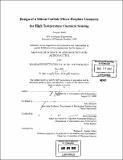| dc.contributor.advisor | John Brisson. | en_US |
| dc.contributor.author | Benn, Gregory (Gregory Scott), 1977- | en_US |
| dc.contributor.other | Massachusetts Institute of Technology. Dept. of Aeronautics and Astronautics. | en_US |
| dc.date.accessioned | 2005-06-02T16:05:11Z | |
| dc.date.available | 2005-06-02T16:05:11Z | |
| dc.date.copyright | 2001 | en_US |
| dc.date.issued | 2001 | en_US |
| dc.identifier.uri | http://hdl.handle.net/1721.1/17535 | |
| dc.description | Thesis (S.M.)--Massachusetts Institute of Technology, Dept. of Aeronautics and Astronautics, 2001. | en_US |
| dc.description | Includes bibliographical references (p. 127-129). | en_US |
| dc.description.abstract | Silicon carbide, high temperature, chemical sensors are the next step in chemical detection technology; allowing for the development of low cost, robust, lower power, and widely applicable chemical sensors. SiC offers the thermal conductivity, electrical properties, and operating temperatures not currently available in silicon sensors. Boston Micro Systems, a Wobum, Massachusetts based company, has developed technologies for bulk manufacturing of single crystal SiC material. Using this technology, geometries optimizing thermal and electrical performance have been developed to create a SiC micro-hotplate for chemical sensors. Under etching allows for the manufacturing of micro-hotplates. Micro hotplates allow sensors to discriminate between chemical species by controlling absorption and desorption of chemicals. Optimization of the performance of such a device is achieved by developing hotplates that are suspended by necked tethers. Tether designs minimize heat lose from the hotplate and necking creates heat generation regions. The excellent thermal properties of SiC allow heat to be transferred from the necked tethers to the hotplate; producing a hotplate with a uniform temperature distribution, important to the sensitivity and accuracy of the sensing film. Testing of tethered and necked hotplates identified several areas of improvement in hotplate design. These include under etching, improvement in the plates response to thermal stresses, and p-n junction performance improvements. Using such design improvements as tethers and necking the thermal performance of SiC micro-hotplates has improved by two orders of magnitude. This thesis discusses the design, modeling, and testing of single crystal SiC micro-hotplates. | en_US |
| dc.description.statementofresponsibility | Gregory Benn. | en_US |
| dc.format.extent | 130 p. | en_US |
| dc.format.extent | 5638312 bytes | |
| dc.format.extent | 5652733 bytes | |
| dc.format.mimetype | application/pdf | |
| dc.format.mimetype | application/pdf | |
| dc.language.iso | eng | en_US |
| dc.publisher | Massachusetts Institute of Technology | en_US |
| dc.rights | M.I.T. theses are protected by copyright. They may be viewed from this source for any purpose, but reproduction or distribution in any format is prohibited without written permission. See provided URL for inquiries about permission. | en_US |
| dc.rights.uri | http://dspace.mit.edu/handle/1721.1/7582 | |
| dc.subject | Aeronautics and Astronautics. | en_US |
| dc.title | Design of a silicon carbide micro-hotplate geometry for high temperature chemical sensing | en_US |
| dc.title.alternative | Thermal design of silicon carbide micro hot plates for high temperature chemical sensing | en_US |
| dc.type | Thesis | en_US |
| dc.description.degree | S.M. | en_US |
| dc.contributor.department | Massachusetts Institute of Technology. Department of Aeronautics and Astronautics | |
| dc.identifier.oclc | 50882127 | en_US |
